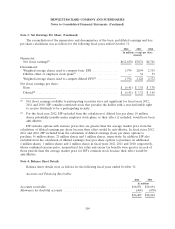HP 2012 Annual Report Download - page 113
Download and view the complete annual report
Please find page 113 of the 2012 HP annual report below. You can navigate through the pages in the report by either clicking on the pages listed below, or by using the keyword search tool below to find specific information within the annual report.HEWLETT-PACKARD COMPANY AND SUBSIDIARIES
Notes to Consolidated Financial Statements (Continued)
Note 7: Goodwill and Purchased Intangible Assets (Continued)
assets, in a hypothetical analysis that calculates the implied fair value of goodwill in the same manner
as if the reporting unit was being acquired in a business combination. If the implied fair value of the
reporting unit’s goodwill is less than the carrying value, the difference is recorded as an impairment
loss.
Except for Services, Software and Corporate Investments, HP’s reporting units are consistent with
the reportable segments identified in Note 19. The ES and TS businesses are the reporting units within
the Services segment. ES includes the ITO and ABS business units. The Software segment includes two
reporting units, which are Autonomy and the legacy HP software business. The webOS business is also
a separate reporting unit within the Corporate Investments segment.
HP estimated the fair value of its reporting units using a weighting of fair values derived most
significantly from the income approach and, to a lesser extent, the market approach. Under the income
approach, HP calculates the fair value of a reporting unit based on the present value of estimated
future cash flows. Cash flow projections are based on management’s estimates of revenue growth rates
and operating margins, taking into consideration industry and market conditions. The discount rate
used is based on the weighted-average cost of capital adjusted for the relevant risk associated with
business-specific characteristics and the uncertainty related to the business’s ability to execute on the
projected cash flows. The market approach estimates fair value based on market multiples of revenue
and earnings derived from comparable publicly-traded companies with similar operating and investment
characteristics as the reporting unit. The weighting of the fair value derived from the market approach
ranges from 0% to 50% depending on the level of comparability of these publicly-traded companies to
the reporting unit. When market comparables are not meaningful or not available, HP may estimate
the fair value of a reporting unit using only the income approach.
In order to assess the reasonableness of the calculated fair values of its reporting units, HP also
compares the sum of the reporting units’ fair values to HP’s market capitalization and calculates an
implied control premium (the excess of the sum of the reporting units’ fair values over the market
capitalization). HP evaluates the control premium by comparing it to control premiums of recent
comparable market transactions. If the implied control premium is not reasonable in light of these
recent transactions, HP will reevaluate its fair value estimates of the reporting units by adjusting the
discount rates and/or other assumptions. As a result, when there is a significant decline in HP’s stock
price, as occurred during fiscal 2012, this reevaluation could correlate to lower estimated fair values for
certain or all of HP’s reporting units.
During fiscal 2012, HP determined that sufficient indicators of potential impairment existed to
require an interim goodwill impairment analysis for the ES reporting unit. These indicators included
the recent trading values of HP’s stock, coupled with market conditions and business trends within ES.
The fair value of the ES reporting unit was based on the income approach. The decline in the fair
value of the ES reporting unit resulted from lower projected revenue growth rates and profitability
levels as well as an increase in the risk factor that is included in the discount rate used to calculate the
discounted cash flows. The increase in the discount rate was due to the implied control premium
resulting from recent trading values of HP stock. The resulting adjustments to discount rates caused a
significant reduction in the fair value for the ES reporting unit. Based on the step one and step two
analyses, HP recorded an $8.0 billion goodwill impairment charge in fiscal 2012, and there is no
remaining goodwill in the ES reporting unit as of October 31, 2012. Prior to completing the goodwill
105
























